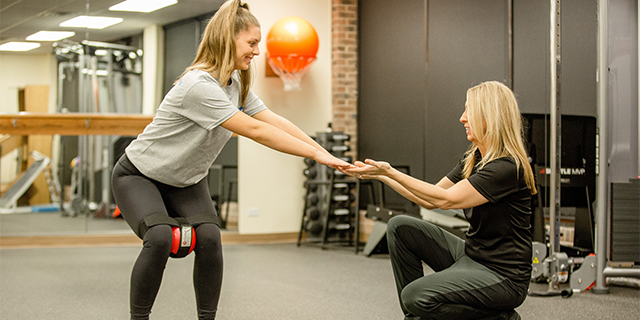Diastasis recti…sounds like an odd sea creature, doesn’t it? If you are a pregnant mom, or have recently delivered, you may be familiar with the term.
Diastasis, meaning “separation,” can affect the rectus abdominus (six-pack) muscles in the front of the abdomen, creating a gap, soft spot, bulge or separation. It also creates a stretching of the linea alba, which is the dense connective tissue between the left and right sides of the rectus muscles.
What is Diastasis Recti?
Diastasis recti (DR) can affect men or women at any age. In fact, we are all born with a small separation between those muscles that eventually closes during the first few years of development. However, if the rectus muscles are stretched for a prolonged period (pregnancy, excess abdominal weight), or if they are strained from weight lifting, chronic coughing, constipation or surgery, the connective tissue and muscles become weak and overstretched. This leaves the abdominal contents vulnerable and tender. One study in the Journal of Physical Therapy suggested that up to 66 percent of pregnant women in their third trimester experience significant DR.1
The rectus abdominus muscle not only supports the abdominal contents, but it is an integral part of your core strength. Think of your “core” as a canister in the very center of your center. That canister is supported in the front by the rectus, on top by the diaphragm, in the back by spinal muscles, and the pelvic floor holds everything up from the bottom. These muscles work in harmony to support your visceral organs and maintain posture and skeletal stability. If the muscles in front are weak, the spine is not supported. A weak core results in pain due to poor spinal stability, postural weakness, gastrointestinal issues, poor bladder control and a body that just isn’t functioning at 100 percent. If there is weakness in the abdominals, the collateral damage begins. It is not just a matter of an annoying, unsightly belly bulge, or an “innie-turned-outtie” belly button.
How do you know if you have a DR?
Here is an easy test you can perform at home:
- Lie on your back and bend your knees.
- Slowly sit up and reach one hand toward your knees.
- Take the fingers of the other hand and palpate the space between the “six-pack” muscles above your navel. If you feel a gap, that is likely a DR.
Some patients note that they can feel their pulse in that space between the muscles, or they get a protruding belly after they eat. DR is considered problematic if it measures greater than 2.7 cm (about 2 finger widths placed horizontally). If you were able to palpate a gap, have someone on your healthcare team assess you.
Can anything be done to close the gap?
I am so glad you asked! The Women’s Health Therapists at Athletico have had specialized training in DR reduction. After you have your initial consultation, the therapist will devise a very specific exercise program for you. The program will target several muscle groups. One of the most important muscles is called the transverse abdominus, which is your body’s own “corset.” This muscle provides critical support to the core and is a powerful spinal stabilizer.
Pelvic floor muscle exercises and hip strengthening may also be prescribed. The pelvic floor is a sling-like group of muscles that lies in the bottom of the pelvis. It creates closure for the urethra, vagina and rectum, so things don’t fall out that aren’t supposed to fall out! Strengthening these muscles prevents urinary and stool incontinence and can improve sexual health. Your physical therapist will also provide helpful information about the different types of abdominal braces/binders that may be helpful, if needed.
It is also important that your physical therapist also advise you on what NOT to do. Believe it or not, crunches, sit-ups and those hard-core, tire-flipping classes may be making your DR worse – despite your good intentions. Other things like constipation, poor posture, straining and breath-holding will be addressed. It is also important to note that your physical therapist may use specialized manual techniques to reduce connective tissue restrictions associated with DR.
 Physical therapy has been proven to be a safe and effective way to help close a diastasis recti. So, Taylor, you were wrong… they ARE getting back together. Contact your local Athletico office for a free consultation with a specialized Women’s Health physical therapist today, and be the best “you” you can be!
Physical therapy has been proven to be a safe and effective way to help close a diastasis recti. So, Taylor, you were wrong… they ARE getting back together. Contact your local Athletico office for a free consultation with a specialized Women’s Health physical therapist today, and be the best “you” you can be!
The Athletico blog is an educational resource written by Athletico employees. Athletico bloggers are licensed professionals who abide by the code of ethics outlined by their respective professional associations. The content published in blog posts represents the opinion of the individual author based on their expertise and experience. The content provided in this blog is for informational purposes only, does not constitute medical advice and should not be relied on for making personal health decisions.
References:
1. Litos, Karen. Progressive Therapeutic Exercise Program for Successful Treatment of a Postpartum Woman With a Severe Diastasis Recti Abdominus. Journal of Women’s Health Physical Therapy 38:2 (May/ August 2014):58-72.
Jovie Murtha was a physical therapist at Athletico Physical Therapy at the time of this blog.

 width="900"
height="356"
>
width="900"
height="356"
>
